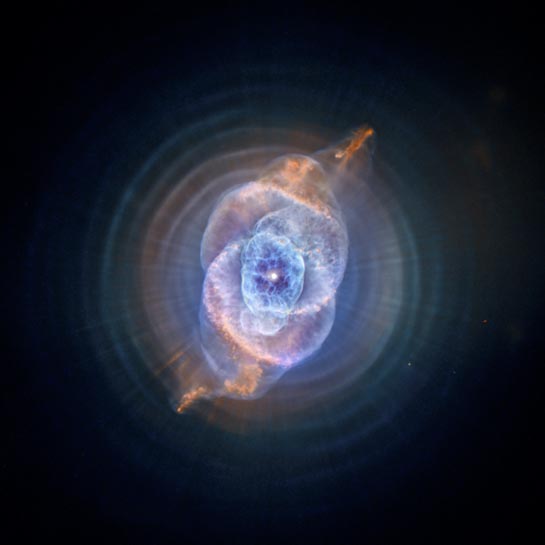
White Dwarfs & Planetary Nebulas
RA 17h 58m 33.30s Dec +66'° 37' 59.20"
Draco
About 3,000 light years
9.8
Image is 1.2 arcmin across. (about 1.7 light years)
10 May, 2000
13 hours
ACIS
X-ray: NASA/CXC/RIT/J.Kastner et al.; Optical: NASA/STScI
October 10, 2012
Links
to other images in the series:
Jan 1995 Jan
2001 Sept 2004 July
2008 Oct 2012
ABOUT THIS IMAGE:
From Wikipedia:
The Cat's Eye Nebula or NGC 6543, is a relatively bright planetary nebula in the northern constellation of Draco, which was discovered by William Herschel on February 15, 1786. It was notably the first planetary nebula whose spectrum was investigated by the English amateur astronomer William Huggins, demonstrating that planetary nebulae were gaseous and not stellar in nature. Structurally, the object has had high-resolution images by the Hubble Space Telescope revealing knots, jets, bubbles and complex arcs, being illuminated by the central hot planetary nebula nucleus or PNN. It is a well-studied object that has been observed from radio to X-ray wavelengths. (see https://en.wikipedia.org/wiki/Cat's_Eye_Nebula for more information)
From Chandra:
This image is one of the planetary nebulae from the first systematic survey of such objects in the solar neighborhood made with NASA's Chandra X-ray Observatory. X-ray emission from Chandra is colored purple and optical emission from the Hubble Space Telescope is colored red, green and blue. (see rollover image for the x-ray composite)
A
planetary nebula is a phase of stellar evolution that the Sun should experience
several billion years from now. When a star like the Sun uses up all of
the hydrogen in its core, it expands into a red giant, with a radius that
increases by tens to hundreds of times. In this phase, a star sheds most
of its outer layers, eventually leaving behind a hot core that will soon
contract to form a dense white dwarf star. A fast wind emanating from
the hot core rams into the ejected atmosphere, pushes it outward, and
creates the graceful, shell-like filamentary structures seen with optical
telescopes.
The diffuse X-ray emission seen in about 30% of the planetary nebulas
in the new Chandra survey is caused by shock waves as the fast wind collides
with the ejected atmosphere. The new survey data reveal that the optical
images of most planetary nebulas with diffuse X-ray emission display compact
shells with sharp rims, surrounded by fainter halos. All of these compact
shells have observed ages that are less than about 5000 years, which therefore
likely represents the timescale for the strong shock waves to occur.
About half of the planetary nebulas in the study show X-ray point sources
in the center, and all but one of these point sources show high energy
X-rays that may be caused by a companion star, suggesting that a high
frequency of central stars responsible for ejecting planetary nebulas
have companions. Future studies should help clarify the role of double
stars in determining the structure and evolution of planetary nebulas.